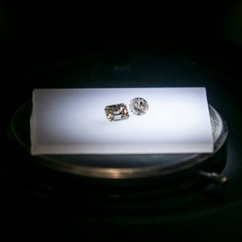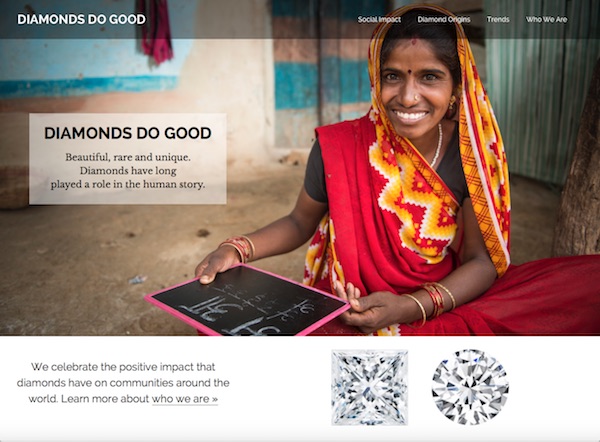Articles and News
Synthetic Diamonds In The Store: Jewelers’ Six Most Urgent Questions Answered February 14, 2018 (0 comments)

Scottsdale, AZ—Following an in-depth panel discussion on synthetic diamonds during the Centurion Scottsdale Show, jewelers had an opportunity to ask the experts their most urgent questions. (Read a summary of the session content here and click here to read a separate article about synthetic diamonds, in which Jeff Feero of Alex Sepkus and multiple other industry members were quoted, appearing last Friday in The New York Times.)
The panel in Scottsdale, moderated by Centurion president Howard Hauben, included Dr. James Shigley, distinguished research fellow at GIA (Gemological Institute of America), Christy Johnson, CCLA, personal lines claims examiner for Jewelers Mutual Insurance Co., and Nick DelRe, chief information officer for Gemological Sciences International, who also sponsored the session. (Image at left: a natural and a synthetic diamond side by side. Can you tell which is which? Photo from The New York Times.)
Staff training and inventory levels. Leslie Panowicz of Panowicz Jewelers in Olympia, WA, asked about the best training materials for staff.
“As your first line of defense you need to have a someone with good diamond grading skills,” said Nick DelRe. “A seasoned diamond grader who has seen lots of diamonds knows the inside of a diamond and can connect to it. This helps in differentiating natural diamonds from the others.
“The next step, once you have these people, have them look at any kind of lab grown synthetic in the marketplace. You can get good education but the bottom line is experience,” he said, adding that usually manufacturers of synthetic goods are happy to lend parcel of goods to look at--but some don’t. “Put pressure on those groups to lend for people to have a look,” he advised.
GIA has produced a lot of information about synthetics, said Shigley. There are many articles in Gems & Gemology, the Institute’s quarterly scientific journal, which is available at no cost online. The articles, which can be downloaded, feature lots of photographs and diagrams that show the internal features of synthetic diamonds, but like DelRe he advises education and training for the staff.
Johnson advised jewelers to ask their synthetic suppliers for training materials as well.
When your reputation is on the line. Hauben, the moderator, asked how many jewelers in the audience require their diamond suppliers to be accountable and liable for selling synthetics undisclosed. A very small percentage of those present do—but most realized they need to.
“Remember, you are liable if you sell one to a consumer undisclosed,” he cautioned.
Jim Rosenheim, chairman of Tiny Jewel Box in Washington, DC, worries most about melee and called for industry action to keep cheaters at bay. “All the bigger stones we sell are certified. We handle thousands of pieces per year filled with smaller diamonds, and my concern is if we end up selling something where the melee has been salted, and it becomes a public issue. The jewelry industry as a whole has the ability to hold the manufacturing industry accountable, so if a manufacturer is either intentionally or unintentionally salting with synthetics, we can blackball those people. We can keep integrity of industry above reproach!”
Disclosure is paramount, reiterated DelRe. “It’s tough to say [to customers] ‘there are a few diamonds in here that might be synthetic and I just can’t tell,’ but at least you’re honest with them. They may well want to buy the piece anyway. They buy fracture-filled diamonds,” he pointed out.
Changing the “bad mining” narrative. Lauren Kulchinsky of Mayfair Jewelers brought up the issue of Millennials and other socially-conscious consumers who want someone to blame for mining and destruction. “They say if you can build it in a lab, then you’re not hurting the earth.”
Johnson reminded the audience there are many different ways to create synthetics. “A lab in China running off fossil fuels is not eco-friendly!”
Shigley added, “Environmentally, diamond mining is not a natural disaster. Diamond mining uses no chemicals like gold, and it is not destructive. When the mine closes, it can be put back or the pit can be made into a lake.”
Hedda Schupak, editor of The Centurion Newsletter, recommended jewelers log onto diamondsdogood.com, the consumer-facing website of the Diamond Empowerment Fund, which is filled with content about the global economic benefits—like education, health care, infrastructure, and clean water—that diamond mining companies have brought to surrounding communities.
“We’ve let the synthetic folks grab the narrative. We have to take it back, because the stories will be told either way. We can tell our own story or they’ll tell their version of our story.”
Above: Homepage of diamondsdogood.com. A retailer toolkit is available to help jewelers leverage content from the organization. The kit includes a digital seal as well as a store decal, in-case signage, social media sharing of stories about diamonds doing good, sample press releases and social media posts, and manager and sales associate training guides. For information, contact Nancy Orem Lyman, executive director, nlyman@diamondempowerment.org.
Detection. Jeweler Brandon Solomon asked about best practices for spotting synthetic diamonds.
“I go back to experience. The more experience the better. It’s a changing landscape,” said DelRe.
Shigley recommended jewelers learn the characteristics of Type IA and IIA diamonds, this is how most testers operate. “Type IIA diamonds with no nitrogen are rare in nature. The vast majority of naturals are Type 1A, which means they have nitrogen, and typical properties absent in IIA. A lot of testers sold use the IA/IIA distinction and if it comes up IIA, test further.”
“If you aren’t sure or you can’t figure it out, send it in,” said Johnson. “It’s more expense but not as expensive as a lawsuit and the damage to your reputation.”
Hauben pointed out that this can be an opportunity for independent jewelers with gemological training to boost their own reputation as a leader and expert.
Absolutely, concurred DelRe, but it takes work. There are instruments available to use [for detection] in a retail setting, but someone needs to familiarize themselves with the instruments and they need to be kept clean and checked, he warned. If not, they can give false positives after a while.
Testing machines. That brought up the question of the machines themselves, and which ones to buy. “I saw two or three and I bought both,” said Texas jeweler Susan Eisen. She’s concerned that not only did she end up buying two machines because she didn’t know which was the one she needed more, but also that the prices of the machines she invested thousands in would drop off sharply in a year or two like computers do.
Both DelRe and Shigley don’t see that happening with diamond testers. Shigley pointed out that testing instruments for jewelers is a small market, not a huge consumer market like computers flat-screen TVs.
“There is a certain cost for components and I don’t see the prices of these things dropping dramatically. The same goes for any sophisticated instruments,” said Shigley.
“Newer versions [that come out] address different problems and you might even have to pay more,” said DelRe. “Unfortunately, it’s a necessary cost to combat the problem.”
“Ask a lot of questions,” advised Shigley. “I would have a clear understanding from vendor on four things: One, how does this work? What’s the scientific principle it uses to identify synthetic from natural? Two, what was your test base to verify what you’re claiming? How many were tested and what were the statistics of false answers? Three, have you published your results so people can read them; and four, does your machine give false results?”
“It seems to me the only way to get definitive answer is to submit to lab,” said Michigan jeweler Randy Cole. “In a store, it’s still intuition and not a definitive answer. After 42 years in business, I still have to face my customer and say, ‘I think it is but I can’t give a definitive answer!’
“100% assurance does exist,” said Shigley. “If you send it to our lab I think you will get 100% assurance. We use a variety of different tests and we have a huge database of information. We are constantly trying to improve screening criteria, but we are pretty confident we can identify any synthetic diamonds that exist.”
Going back to his earlier point that synthetics fall into three categories, he emphasized that melee is the only one that’s a real issue.
Should you stock synthetics? “They’re here to stay,” said Virginia jeweler Jenny Caro. “We have to recognize it’s a growing part of the market. We offer a choice of everything from Hearts On Fire to diamonds bought off the street to lab-grown.”
Leslie Panowicz asked about the best ratio of natural to synthetic to stock.
“It depends who you’re selling to,” advised Johnson. “A lot of people will never be interested in a synthetic, but if you’re selling to Millennials getting married, that’s probably a good market. Milliennials saw Blood Diamonds, they’re into technology, et cetera, so that’s probably a good market [for synthetics].”
“It’s money,” said Caro bluntly. “You can get a carat and a half for the price of a carat. Millennials are happy and thrilled to get a beautiful diamond and they don’t care that much about naturals.”
Editor's note: in the image at top of page, the synthetic diamond is the one on the left. Photo: The New York Times.








